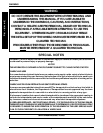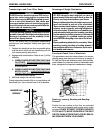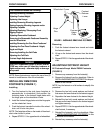
7
WARNING
There are a number of sources of relatively intense electromagnetic fields in the everyday environ-
ment. Some of these sources are obvious and easy to avoid. Others are not apparent and exposure is
unavoidable. However, we believe that by following the warnings listed below, your risk to EMI will be
minimized.
The sources of radiated EMI can be broadly classified into three types:
1) Hand-held Portable transceivers (transmitters-receivers with the antenna mounted directly on
the transmitting unit. Examples include: citizens band (CB) radios, "walkie talkie", security, fire and
police transceivers, cellular telephones, and other personal communication devices. **NOTE:
Some cellular telephones and similar devices transmit signals while they are ON, even when not
being used;
2) Medium-range mobile transceivers, such as those used in police cars, fire trucks, ambulances,
and taxis. These usually have the antenna mounted on the outside of the vehicle; and
3) Long-range transmitters and transceivers, such as commercial broadcast transmitters (radio and
TV broadcast antenna towers) and amateur (HAM) radios.
NOTE: Other types of hand-held devices, such as cordless phones, laptop computers, AM/FM radios,
TV sets, CD players, cassette players, and small appliances, such as electric shavers and hair dryers, so
far as we know, are not likely to cause EMI problems to your powered wheelchair.
Powered Wheelchair Electromagnetic Interference (EMI)
Because EM energy rapidly becomes more intense as one moves closer to the transmitting antenna
(source), the EM fields from hand-held radio wave sources (transceivers) are of special concern. It is
possible to unintentionally bring high levels of EM energy very close to the powered wheelchair's con-
trol system while using these devices. This can affect powered wheelchair movement and braking.
Therefore, the warnings listed below are recommended to prevent possible interference with the con-
trol system of the powered wheelchair.
Electromagnetic interference (EMI) from sources such as radio and TV stations, amateur radio (HAM)
transmitters, two-way radios, and cellular phones can affect powered wheelchairs and motorized scoot-
ers. Following the warnings listed below should reduce the chance of unintended brake release or
powered wheelchair movement which could result in serious injury.
1) Do not operate hand-held transceivers (transmitters receivers), such as citizens band (CB) radios,
or turn ON personal communication devices, such as cellular phones, while the powered wheel-
chair is turned ON;
2) Be aware of nearby transmitters, such as radio or TV stations, and try to avoid coming close to
them;
3) If unintended movement or brake release occurs, turn the powered wheelchair OFF as soon as it
is safe;
4) Be aware that adding accessories or components, or modifying the powered wheelchair, may
make it more susceptible to EMI (Note: There is no easy way to evaluate their effect on the overall
immunity of the powered wheelchair); and
5) Report all incidents of unintended movement or brake release to the powered wheelchair manu-
facturer, and note whether there is a source of EMI nearby.
Important Information
1) 20 volts per meter (V/m) is a generally achievable and useful immunity level against EMI (as of
May 1994) (the higher the level, the greater the protection);
2) The controllers for this application have unknown immunity levels.
Modification of any kind to the electronics of this wheelchair as manufactured by Invacare may ad-
versely affect the RFI immunity levels.
G
E
N
E
R
A
L
G
U
I
D
E
L
I
N
E
S
PROCEDURE 1GENERAL GUIDELINES


















